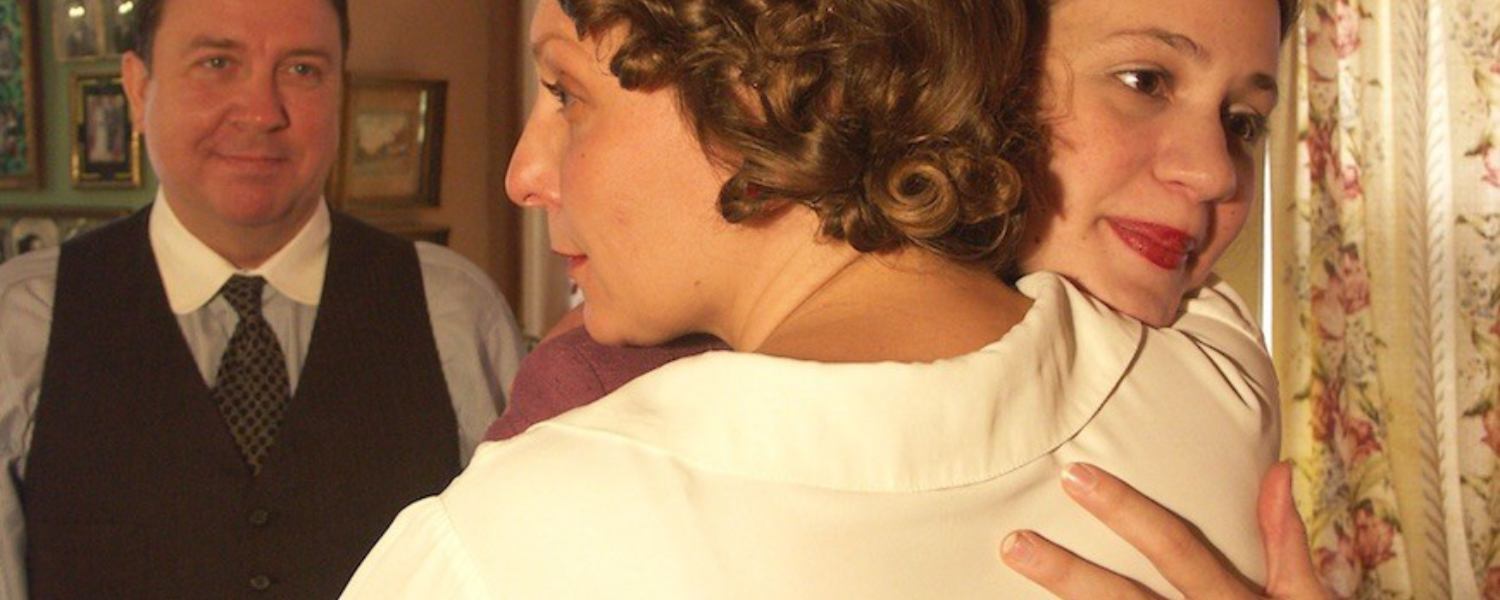
L to R: Terry Hamilton, Isabel Liss, and Dana Black in THIS HAPPY BREED, Timeline Theatre, 2004 (Photo by Lara Goetsch)
This Happy Breed
Music written and performed by Andy Hansen
Revised 2020
from the 2004 Timeline Theatre production of
THIS HAPPY BREED by Noël Coward
Directed by Nick Bowling
Set Design by Tom Burch
Costume Design by Nicole Rene Burchfield
Lighting Design by Charles Cooper
Projections Design by Mike Tutaj
Dramaturgy by Jennifer Shook
THIS HAPPY BREED tells the story of an English family in the period between World War I and World War II. The play is in three acts, each of which has three scenes. There is a passage of time between every scene, most being at least 1 year. Staging a play that takes place over 20 years requires several changes of costume and, if you’re really ambitious, changes of scenery. Director Nick Bowling is always creatively ambitious, and the scene change in our production involved both.
This takes time, and rather than having the audience sit in an awkward blackout for a minute or two, he and Dramaturg Jennifer Shook conceived the idea of covering the changes with short historical films tied to a major event relevant to the next scene. The scenes lined up with significant events, often by Noël Coward’s design, and frequently they were documented by newsreels of the day. Projections Designer Mike Tutaj assembled this footage into coherent and visually interesting films that were accompanied by music. The score for “THIS HAPPY BREED” is the score for those films.
It probably would have been easier to find a recording of whatever hit song of the day fit the scene change. I have mostly done shows in that manner. For this show, that approach felt disconnected to the essence of the play. It’s a very human story in the midst of events the characters neither influence nor control. They are not players in that world, and our focus is on them. The play needed its own voice, and I didn’t want it stylistically connected to any particular time. As such, the score isn’t interested in the specifics of the historical events but rather the idea that time continues to push forward. That said, it does follow the emotional shifts in the family story.
As you will hear, the score quotes some English hymn tunes which are noted in the guide below. In addition I wrote a “departure and return” theme that goes up (departure) then settles back down (return). This came from Nick’s desire to give focus to the story of the daughter who runs away midway through the play and returns again in the penultimate scene. The theme is first heard as she leaves, again when she returns, and in a finale of sorts where I combined several ideas from earlier pieces into single cue.
Every now and then you work on a show that nearly everyone involved remains attached to for years to come. This was one of those shows.
Listening Guide
| TIME | TITLE | HISTORICAL EVENT | MUSIC NOTE |
|---|---|---|---|
| 0:00 - 1:36 | Versailles | 1919, End of World War I | Quote from “I Vow To Thee My Country”, music by Gustav Holst |
| 1:40 - 3:08 | Locarno | Dec 1925, Pact of Locarno, European Peace Treaty | Quote from “Good King Wenceslas” |
| 3:09 - 4:08 | General Strike | May 1926, labor strike in England | Quote from “Jerusalem”, music by Sir Hubert Parry |
| 4:10 - 5:28 | Re-Election | Oct 1931, Conservative sweep in the UK general election. | |
| 5:31 - 6:37 | Manchuria | Nov 1931, Japan Invades Manchuria | Departure and Return I |
| 6:38 - 7:25 | Assassination | May 1932, Assassination of Japanese Prime Minister in a military coup | Quote from “Oh God Our Help In Ages Past”, music by William Croft |
| 7:26 - 8:51 | Abdication | Dec 1936, King Edward abdicates the throne of the United Kingdom. | |
| 8:54 - 9:37 | Munich | Sep 1938, the Munich Agreement gives Hitler the Sudetenland | Departure and Return II |
| 9:41 - 10:55 | Pact of Steel | June 1939, a pact between Germany and Italy, linking them politically and militarily | Departure and Return III |